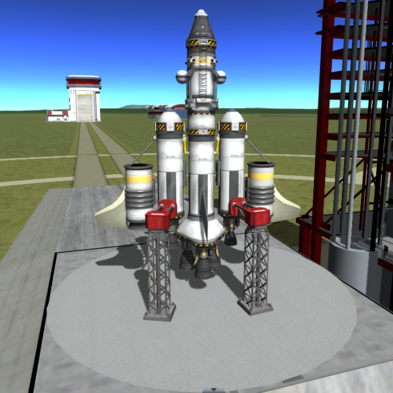Difference between revisions of "Demo parts"
From Kerbal Space Program Wiki
UmbralRaptor (talk | contribs) |
(Changed Picture to V0.18.3 Demo Rocket) |
||
| Line 1: | Line 1: | ||
{{Outdated|Obsolete due to demo being brought up to 0.18.3. Demo parts may diverge again, however.}} | {{Outdated|Obsolete due to demo being brought up to 0.18.3. Demo parts may diverge again, however.}} | ||
| − | [[Image:All-parts-rocket-0. | + | [[Image:All-parts-rocket-0.18.3.png|393px|right|thumb|A Four-stage rocket featuring each of the default parts as of V0.18.3. The V0.8.5 rocket can be found [[File:All-parts-rocket-0.8.5.ogg|Here.]]]] |
This page lists the rocket '''parts''' that are included with the free demo version ''Kerbal Space Program'', currently 0.13.3. These parts are also called '''vanilla parts''' or '''default parts'''. | This page lists the rocket '''parts''' that are included with the free demo version ''Kerbal Space Program'', currently 0.13.3. These parts are also called '''vanilla parts''' or '''default parts'''. | ||
Revision as of 23:50, 2 May 2013
| This page or section is in need of being brought up to date. Please help Kerbal Space Program Wiki by fixing inaccurate or outdated information. Obsolete due to demo being brought up to 0.18.3. Demo parts may diverge again, however. |

A Four-stage rocket featuring each of the default parts as of V0.18.3. The V0.8.5 rocket can be found Here.
This page lists the rocket parts that are included with the free demo version Kerbal Space Program, currently 0.13.3. These parts are also called vanilla parts or default parts.
For a list of all the parts available in the paid version of Kerbal Space Program, look at the paid parts page.
Contents
Units of measure
- While units are not specifically labeled in-game, a bit of logic can quickly determine that thrust is measured in kilonewtons (kN) and mass in metric tons (t). For example, if measured in kilograms(kg), a "9 kg" Rockomax X200-16 Fuel Tank on Kerbin, having a surface gravity of 9.81 m/s2, would be roughly the size of a 48 oz coffee tin and only hold about 1.5 L of fuel. If measured in metric tons, a 9 t Rockomax X200-16 Fuel Tank under the same gravity would be about 0.67 m tall and 2 m in diameter, easily capable of holding the advertised 1600 L of fuel. Only a rocket engine with a thrust around 100 kN could have any chance to lift a 9 t fuel tank.
- It is likely that the game engine uses kg to calculate part mass in the background but displays metric tons for parts in the user interface to save on screen space. It is also easier to read 20 "t" than 20000 "kg" (1 metric ton = 1000 kg).
- To reduce confusion, specific impulse is given in both velocity and time units. Please see the discussion page for further reading on ways of expressing specific impulse.
Command Pods
| Part | Mass (t) |
|---|---|
| Command Pod Mk1 (Demo) | 1 |
Propulsion
| Part | Thrust (kN) | Mass (t, full / empty) | Fuel Units | Fuel Consumption (L/s) | Specific Impulse (m/s) | Specific Impulse (s) |
|---|---|---|---|---|---|---|
| FL-T500 Fuel Tank | n/a | 2.5 / 0.3 | 500 | n/a | n/a | n/a |
| LV-T30 Liquid Fuel Engine | 200 | 2 | n/a | 8 | 5682 | 579.375 |
| LV-T45 Liquid Fuel Engine | 175 | 2 | n/a | 7 | 5682 | 579.375 |
| RT-10 Solid Fuel Booster | 130 | 1.8 / 0.36 | 100 | 4 | 2257 | 230.141 |
| FL-R25 RCS Fuel Tank | n/a | 0.9 / 0.15 | 250 | n/a | n/a | n/a |
| RV-105 RCS Thruster Block | 1 | 0.05 | n/a | 0.2 | 1667 | 169.95 |
Command & Control
| Part | Mass (t) |
|---|---|
| S.A.S. Module | 0.8 |
| Advanced S.A.S. Module | 0.8 |
Structural & Aerodynamic
| Part | Mass (t) |
|---|---|
| TT-38K Radial Decoupler | 0.4 |
| TR-18A Stack Decoupler | 0.8 |
| TVR-1180C Mk1 Stack Tri-Coupler | 0.8 |
| AV-T1 Winglet | 0.05 |
| AV-R8 Winglet | 0.08 |
| EAS-4 Strut Connector | 0.05 |
| FTX-2 External Fuel Duct | 0.05 |
Utility & Scientific
| Part | Mass (t) |
|---|---|
| Mk16 Parachute | 0.3 |
Decals
No parts in this section yet
Crew
No parts in this section yet.